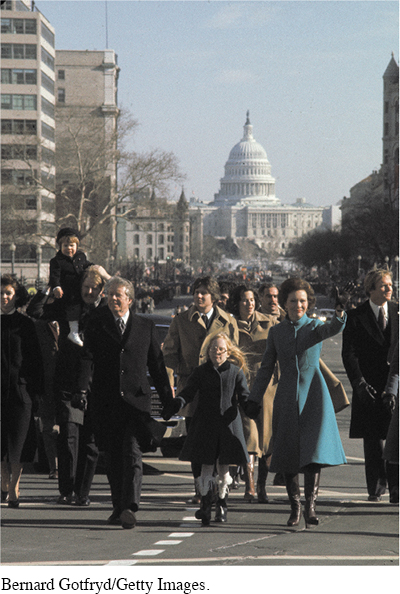The American Promise: Printed Page 870
The American Promise, Value Edition: Printed Page 788
The American Promise: A Concise History: Printed Page 900
Retreat from Liberalism
Carter vowed “to help the poor and aged, to improve education, and to provide jobs,” but at the same time “not to waste money.” When these goals conflicted, budget balancing took priority over reform. Carter’s approach pleased Americans unhappy about their tax dollars being used to benefit the disadvantaged while stagflation eroded their own standard of living. But his fiscal stringency frustrated liberal Democrats pushing for major welfare reform and a national health insurance program. Carter himself said, “In many cases I feel more at home with the conservative Democratic and Republican members of Congress than I do with the others.”
The American Promise: Printed Page 870
The American Promise, Value Edition: Printed Page 788
The American Promise: A Concise History: Printed Page 900
Page 871Although Carter did fulfill liberals’ desire to make government more inclusive by appointing unprecedented numbers of women and minorities to cabinet, judicial, and diplomatic posts, a number of factors thwarted Carter’s policy goals. His outsider status helped him win the election but left him without strong ties to party leaders in Congress. Democrats complained that Carter flooded them with comprehensive proposals without consultation or a strategy to get them enacted. Even if he had possessed Lyndon Johnson’s political skills, Carter might not have done much better. The economic problems he inherited—

Carter first targeted unemployment, signing bills that pumped $14 billion into the economy through public works and public service jobs programs and cutting taxes by $34 billion. Unemployment receded, but then inflation surged. Working people, wrote one journalist, “winced and ached” as their paychecks bought less and less, “hollowing their hopes and dreams, their plans for a house or their children’s college education.” To curb inflation, Carter curtailed federal spending, and the Federal Reserve Board tightened the money supply. Not only did these measures fail to halt inflation, which surpassed 13 percent in 1980, but they also contributed to rising unemployment, reversing the gains made in Carter’s first two years.
Carter’s commitment to restraining the federal budget frustrated Democrats pushing for comprehensive welfare reform, national health insurance, and a substantial jobs program that would make government the employer of last resort. His refusal to propose a comprehensive national health insurance plan, long a key Democratic Party objective, led to a bitter split with Massachusetts senator Ted Kennedy, who fought Carter for the 1980 presidential nomination. Carter’s agreement to legislation to ensure solvency in the Social Security system resulted in higher payroll taxes on lower-
By contrast, corporations and wealthy individuals gained from new legislation, such as a sharp cut in the capital gains tax. When the Chrysler Corporation approached bankruptcy, Congress provided $1.5 billion in loan guarantees to bail out the auto giant. Congress also acted on Carter’s proposals to deregulate airlines in 1978 and the banking, trucking, and railroad industries in 1980, beginning a policy turn toward implementing conservatives’ insistence on a free market and unfettered private enterprise.